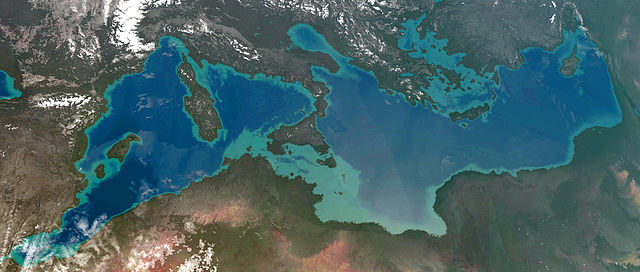Atlantropa
For much of the early 1900s, many German leaders were espousing a political science theory called Lebensraum, literally “space of life.” Lebensraum advocates argued that overpopulation required a solution, and that solution should simply be to acquire more space. The theory was prominent leading up to and continuing after World War I. As Nazism rose, Lebensraum became a rallying cry — the self-declared superior Aryans saw the theory as a mandate to annex the lands of allegedly inferior people, taking it for themselves. But Lebensraum wasn’t necessarily a theory that demanded evil. While the most straightforward way to spread is to take over the land of others, there could be another way — create new lands. Easier said than done, especially when you need to find enough land for literally millions of people. Doing so would require a public works project larger than anything the world has ever seen.
Like draining the Mediterranean Sea.
In the 1920s, a German architect named Herman Sorgel proposed creating a dam across the Strait of Gibraltar, turning the area into a massive hydroelectric plant, creating enormous amounts of renewable energy. (That part of the plan is still, sometimes, suggested today.) But that wasn’t the main goal of the proposed eight-mile dam. Sorgel’s top objective was to stem the flow of water into the Mediterranean; over time, the water level would drop, creating more inhabitable land in both Southern Europe and Northern Africa. As seen by an artist’s conception of what the area would look like, below (larger version here; map of the current Mediterranean here), Italy would become less of a boot as the Adriatic Sea all but disappears. Sicily would nearly double in size, connect to mainland Italy, and be accessible by bridge from Tunisia. Less obviously, low-lying lands would emerge basically everywhere, as hundreds if not thousands of square miles of habitable space would be reclaimed from the sea. Rail lines — not pictured — would connect Paris to Dakar, Senegal (via the Gibraltar dam) and Berlin to Tunis, Tunisia (via Italy and Sicily). Europe and Northern Africa would, effectively, merge.

Sorgel called this new, merged continent “Atlantropa.” Sorgel’s plan, unlike the Nazi’s plan of forced annexations, was kind to his fellow Europeans — but it was still not very peaceful. It explicitly called for the European colonization of Northern Africa and, implicitly, the eradication of native African cultures. But that concern was mostly ignored by Sorgel’s supporters and detractors alike, as were environmental concerns caused by a massive reworking of a major ecosystem. What got in the way? World War II. The Atlantropa Project’s support was strongest toward the end of the 1920s and into the 1930s but waned as Hitler rose to power. In 1942, the Nazis banned Sorgel from publishing his plans further. Atlantropa was dead.
After the War, the movement saw something of a revival. But the costs were too high for a continent requiring rebuilding and the political climate was not conducive to a pan-European project. Sorgel died in 1952, and soon after, any remaining support for Atlantropa died as well.
Bonus fact: In 1934, a New York City engineer proposed placing dams at the Hudson River at both ends of Manhattan and filling in the now-dry area between New York City and northern New Jersey. The engineer estimated that the project would add an additional 10 square miles to Manhattan (which is about 22.7 square miles as it stands) at the cost of $1 billion ($17 billion in today’s dollars). The proposal never went past the idea phase.
From the Archives: Eternal Vacancy: A small piece of developed but uninhabited land in the Mediterranean.
Related: A hydroelectric kit used for teaching about the energy source. Five stars from five reviews, but expensive.
